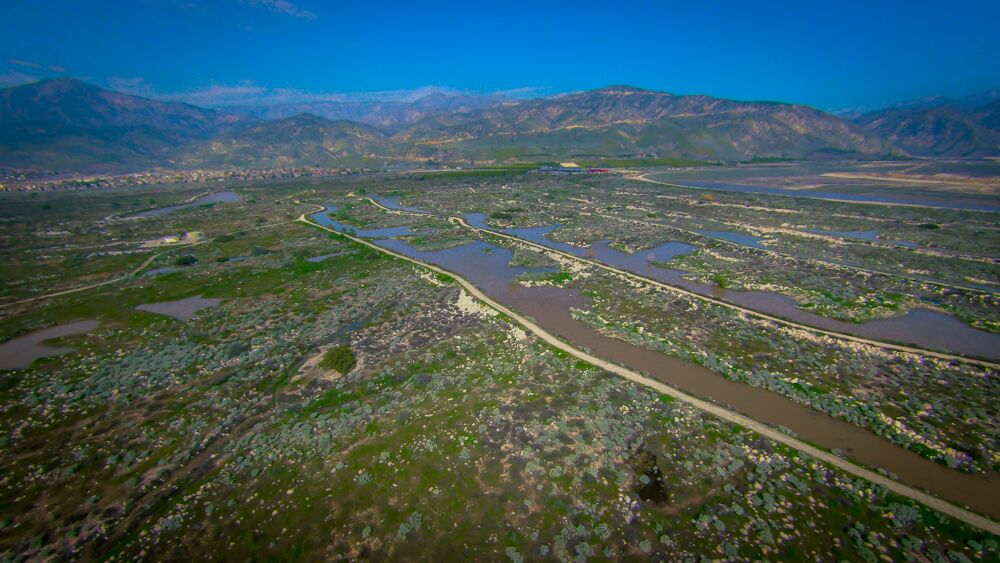
At a time when communities throughout the state are jostling for water resilience and independence, the San Bernardino Valley Water Conservation District today marks its 90th year of supporting local groundwater to serve surrounding communities.
The District was formed on Jan. 4, 1932, following a vote of local citizens to create a public agency to protect against the excessive export of local surface water by downstream agencies. Capturing water flow and diverting it into ponds to recharge the Bunker Hill groundwater basin ensured a reliable, local source of high-quality water to irrigate agriculture, drive the economy and serve the growing population.
“We have been stewards of groundwater and our land from the very start,” said General Manager Daniel Cozad. “We help nature store our water, and with a little innovation and a lot of collaboration we are able to significantly enhance groundwater recharge beyond levels that could be done in the past.”
The District may be marking its 90th year today, but its origins date back even father – to 1910, when the Water Conservation Association was organized to conserve the water of the Santa Ana River. The WCA was dissolved, and its land and property were transferred to SBVWCD.
Ideally situated at the foot of the San Bernardino Mountains, the San Bernardino Valley receives plentiful rain and snowmelt from those lofty peaks. The District sculpts and contours the land within the Upper Santa Ana River Wash to redirect and capture that flow – giving the water the time it needs to percolate into the ground below.
“The unique geographic and topographic features of our valley are ideal for storing water,” said Land Resources Manager and Assistant General Manager Betsy Miller Vixie. “Our work is all about accomplishing recharge in the right place while taking care to not impact the other resources in the same area.”
In recent years, collaboration among water agencies, cities and other partner organizations has broadened the District’s role to include habitat restoration, including the protection of native, threatened and endangered species.
SBVWCD in 2018 helped form the San Bernardino Basin Groundwater Council, a 21st century model for cooperation in which member agencies work together – pitching in their fair share – to achieve optimum levels of water storage in the San Bernardino groundwater basins.
In 2019, the District completed its decades-long goal of establishing a habitat conservation plan, approved by the U.S. Fish and Wildlife Service, to ensure the ongoing expansion of sensitive habitat and water conservation in the Santa Ana River Wash, while supporting the local mining industry and the thousands of construction jobs it provides to the region. Referred to as the Wash Plan, the project promotes:
- Water independence: Allowing for enhanced recharge of local water into the Bunker Hill basin
- Job security: Designating disturbed land for aggregate mining supports local construction jobs, which provide $36 million in payroll annually to the region
- Environmental stewardship: The creation of a nature preserve for native, threatened and endangered species, to be funded in perpetuity
- Safer infrastructure: Improved roads and flood control to address safety issues of the past
- Healthier modes of travel: Bicycle trails and bike lanes to improve public safety and encourage healthier modes of transportation that reduce greenhouse gas emissions
- Access to nature: A network of 12 local nature trails, and a vital connection to the 110-mile Santa Ana River Trail system from the Orange County coast to the San Bernardino mountains
And in 2020, the District completed construction of Plunge Creek Conservation Project, calling for the re-establishment of intermittent flooding necessary to restore hundreds of acres of habitat while increasing groundwater recharge. Tracking of the San Bernardino kangaroo rat will take place for up to 10 years after project implementation to gain a full understanding of long-term project benefits.
Looking forward, 2022 will show significant results from the hard work the District has done in the past.
“Board leadership has tilled the soil and sown the seeds,” Cozad said. “Our 90-year history and accomplishments are valued, but the new projects that are being designed now for groundwater recharge and habitat conservation will bear fruit for the next 90 years.”
About the San Bernardino Valley Water Conservation District
For nearly a century, the SBVWCD has stewarded the San Bernardino Valley water basin and the native species of the Upper Santa Ana River Wash. Its collaborative approach to project management assures high-quality local water supplies for people, agriculture, and the environment. This includes groundwater recharge and oversight, and protection of habitat and native species in the Wash. Visit www.sbvwcd.org.
